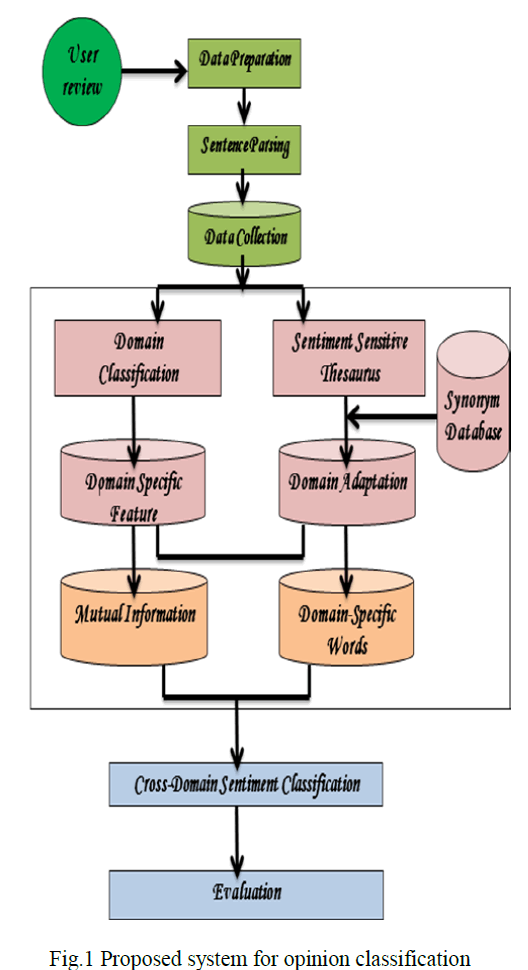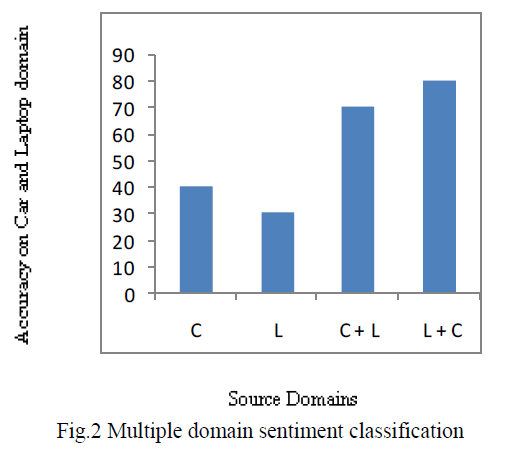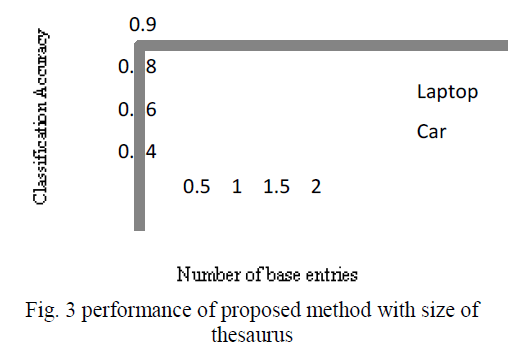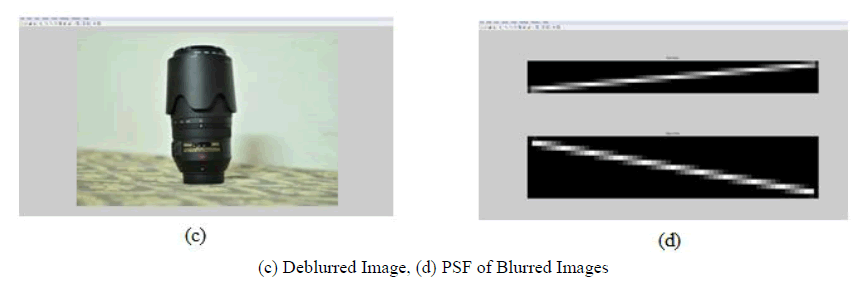ISSN ONLINE(2319-8753)PRINT(2347-6710)
ISSN ONLINE(2319-8753)PRINT(2347-6710)
| Sandeep Mishra1, Abanikanta Pattanayak2, Radhanath Patra3, Subhrajit Pradhan4, Subodh Panda5 3RDSem, M.Tech, Dept. of ECE, Gandhi Institute of Engineering & Technology, Gunupur, Odisha, India 1 3RDSem, M.Tech, Dept. of ECE, Gandhi Institute of Engineering & Technology, Gunupur, Odisha, India2 Head, M.Tech, Dept. of ECE, Gandhi Institute of Engineering & Technology, Gunupur, Odisha, India3 Head, Dept. of ECE, Gandhi Institute of Engineering & Technology, Gunupur, Odisha, India4 Head, Dept. of AE&IE, Gandhi Institute of Engineering & Technology, Gunupur, Odisha, India5 |
| Related article at Pubmed, Scholar Google |
Visit for more related articles at International Journal of Innovative Research in Science, Engineering and Technology
An Adaptive method for Image Deblurring is presented here. Processing of image data collected from both surveillance camera and on road traffic control motor vehicle camera is a big issue because often the objects are in motion and sometimes both the objects and camera are not steady. This leads to Blurring of the image and further image processing is not possible due to the degradation of received image. So Image Deblurring techniques are applied before enhancement or further processing. But it needs proper data for Deblurring like the frequency characteristics (Point Spread Function (PSF)) and Noise characteristics (Noise-to-Signal Power Ratio(NSR)). The method presented here gives the above information along with the motion information. The information about motion detection is very important because in the Deblurring process the noise estimation cannot be done without knowing actual pixels of the sensor noise present in the image. So to get a deblurred image with proper noise reduction that can be further processed in the RTS (Road Traffic & Safety) controller required information are provided sequentially according to the motion detection and Deblurring algorithm. This method uses some good Deblurring methods like Blind Deconvolution and Regularization filtering along with proper motion detections and characteristics estimations to get an image close to the true image which is sufficient for further processing.
Keywords |
| Image Deblurring, Harr Wavelet transformation, Blind Deconvolution, Gyroscopic Sensor, Regularized Filtering, Traffic Surveillance |
INTRODUCTION |
| For Traffic Queue length measurement, Vehicle Tracking, Traffic Control, Road Traffic Security proper processing of image taken from surveillance or traffic control motor vehicle is required [8]. As the vehicles or people sometimes are in motion, blurring occurs in the image and further processing cannot be done. So at the first stage Deblurring technique is applied and then some further processing like spatial transformations and image enhancements. The Deblurring technique uses parameters like PSF, NSR which need to be estimated or found from external devices used for capturing of the image. If Deblurring is done by considering only the object motion then the noise reduction is improper because in some image the traffic control motor vehicle is also in motion whose image sensor is mainly responsible for the Noise in the blurred image. So an Adaptive motion detection technique is given here which takes both surveillance camera and vehicle camera into consideration, for image deblurring. The method determines whether sensor information is available or not. Accordingly it applies separate deblurring techniques. The PSF and NSR are determined in the earlier case by using the sensor information and is used for deblurring process. |
II. RELATED WORK |
| Image from the central traffic control center or from stored frame database is selected and is given to the process [5]. The information required is determined earlier and the values are stored before and are directly used in the process. If some of these parameters are absent then they are set to the default values that are considered to be null in the process. The process is a Split and Joined type as for different conditions separate exclusive algorithms are used for processing and the results from them are the final results. |
| A flow chart on the complete method is given below which have multiple image outputs, but gives only one output from the several processes. Three different conditions are applied here, some with nested conditions. |
| 1. Degraded Image Detection |
| 2. Sensor Information Availability |
| 3. Sensor Motion Detection |
 |
| The degraded image detection is done by using Harr Wavelet transformation where an initial PSF is estimated by using the Blur extent factor present in the image [10]. This parameter can later be used in the Blind Deconvolution algorithm as the INITPSF. If blurring is found the degraded image can be represented as |
| Where, DI: Degraded image i.e. the blurred image HO: Distortion operator that describes the degree to which an optical system blurs (spreads) a point of light when the object is in motion. HB: Distortion operator that describes the degree to which an optical system blurs (spreads) a point of light when both the object and the camera are in motion. N: The Additive noise, introduced during image formation, that degrades the image |
| The distortion operators, when convolved with the imagecreate the distortion.On this model, the method of deblurring is to deconvolve the blurred image with the PSF that exactly describes the distortion according to the condition available. Deconvolution is the process of reversing the effect of convolution that occurred during the degradation. |
| When the sensor information is not available then the method uses Blind Deconvolution for deblurring which uses initial Blur extent as the PSF and gives an approximate image output. It is further checked by the blur detection algorithm and if more Deconvolution is required it sends a feedback to the previous process and this continues till an image is formed which is close to the true image. If the sensor information is available then the method applies image deblurring using regularized filtering after checking the sensor motion [2]. For only object motion the cross point sensor characteristics is used for PSF estimation and is given to the Regularized filter. If both object and the sensor are in motion then along with the previous information the vibrating structure gyroscopic characteristics is used for filtering. |
| The external data (if available) is stored before applying the method and used in different process as per the condition. Some of these processes are iterative processes, so manual feedback is required before further processing (The manual feedback can be given by Human or a properly programmed computer.) |
 |
| Here two different images are processed (Object_Move and Both_Move) which are similar to two image frames taken from real surveillance camera and traffic control motor vehicle camera respectively. The PSF of both the images are estimated and these can be deblurred using Blind Deconvolution. The Camera movement information is not available in these images but can be found by using the gyroscopic sensor information connected to the camera. Also the vehicle or people movement information can be found by using the cross point focus movement. The estimated PSF of the blurred images are given below by using which the true image is almost recovered. |
III. RESULTS |
| Here two different images are processed (Object_Move and Both_Move) which are similar to two image frames taken from real surveillance camera and traffic control motor vehicle camera respectively. The PSF of both the images are estimated and these can be deblurred using Blind Deconvolution [1]. The Camera movement information is not available in these images but can be found by using the gyroscopic sensor information connected to the camera. Also the vehicle or people movement information can be found by using the cross point focus movement. The estimated PSF of the blurred images are given below by using which the true image is almost recovered. |
 |
| For getting the best result the information like focus point movement from cross sensor and vibrating gyroscopic sensor characteristics are required [7]. In RTS Controller all these information can be integrated and only by changing the deblurring method using the above data the best deblurred image can be formed and analysis, transformation and the enhancement can be improved. The images presented here are having very less amount of noise due to the good sensor, so NSR estimation technique is not used. The noise characteristics mainly depend upon the type of camera sensor. Surveillance cameras or the traffic control motor vehicle camera are not having the best sensors due to large network of analysis and processing, so good noise estimation techniques are also required. |
 |
IV. CONCLUSION |
| Here we have presented an integrated image deblurring technique that features the adaptive motion detection and Blur detection using Harr wavelet transformation. This method can be used as preprocessor to a RTS controller or can be integrated with it. Deblurring process is not done only on the images that are blurred due to the vehicle motion or people movement but sometimes both the camera and the vehicles are in motion, so these kinds of images should be deblurred. The proposed technique can do this by using different characteristics of sensor. It mainly does a proper NSR estimation to make sure the right noise pixels are recovered. In real-time processing of the traffic data the video data is splited into frames and the individual frames are processed. The method is tested using the Blind Deconvolution after the second condition is false. Due to the good image sensor only the PSF information is estimated and the image is deblurred to a good extent. Further extension to this method can be done by using Camera and GSM module inside the user cars and to send the information to central traffic control center for tracking and controlling thieves by processing the image data from the camera connected in the user car [9]. |
References |
|